jump cable TOYOTA C-HR 2022 Owners Manual
[x] Cancel search | Manufacturer: TOYOTA, Model Year: 2022, Model line: C-HR, Model: TOYOTA C-HR 2022Pages: 818, PDF Size: 113.75 MB
Page 751 of 818

7497-2. Steps to take in an emergency
C-HR_HV_OM_Europe_OM10720E
7
When trouble arises
If the 12-volt batter y is discharged
If you have a set of jumper (or booster) cables and a second vehicle
with a 12-volt battery, you can jump start your vehicle by foll owing the
steps below.
Vehicles with an alarm
( P. 147):
Confirm that the electronic key
is being carried.
When connecting the jumper (or
booster) cables, depending on the
situation, the alarm may activate
and the doors may lock. ( P. 150)
2ZR-FXE engine: Open the hood. (P. 596)
M20A-FXS engine: Open the
hood. ( P. 596) and fuse box
cover.
M20A-FXS engine: Open the
exclusive jump starting termi-
nal cover.
The following procedures may be used to start the hybrid sys-
tem if the vehicle’s 12-volt battery is discharged.
You can also call any authorized Toyota retailer or Toyota auth o-
rized repairer, or any reliable repairer or a qualified repair shop.
1
2
3
Page 752 of 818
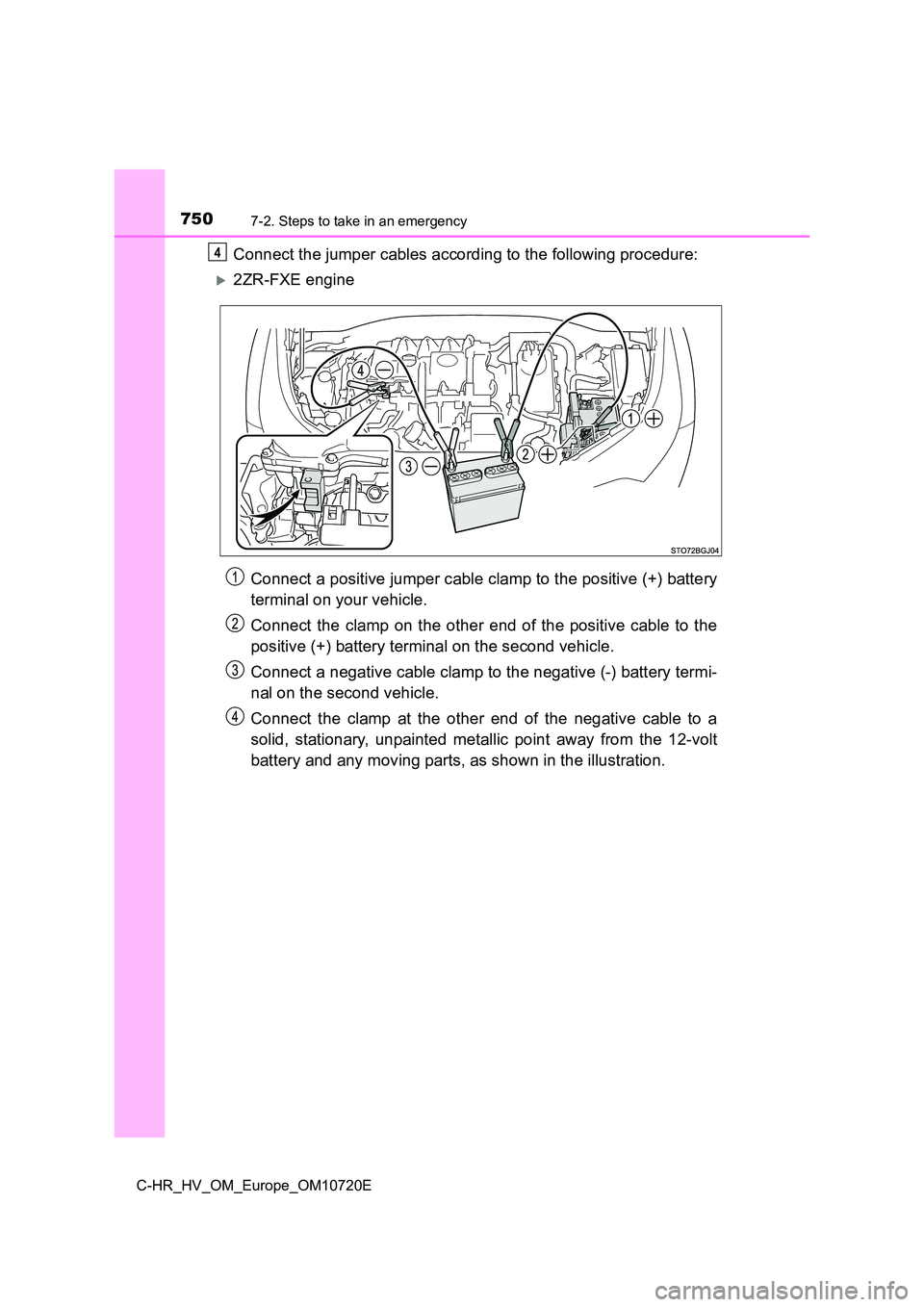
7507-2. Steps to take in an emergency
C-HR_HV_OM_Europe_OM10720E
Connect the jumper cables according to the following procedure:
2ZR-FXE engine
Connect a positive jumper cable clamp to the positive (+) batte ry
terminal on your vehicle.
Connect the clamp on the other end of the positive cable to the
positive (+) battery terminal on the second vehicle.
Connect a negative cable clamp to the negative (-) battery term i-
nal on the second vehicle.
Connect the clamp at the other end of the negative cable to a
solid, stationary, unpainted metallic point away from the 12-vo lt
battery and any moving parts, as shown in the illustration.
4
Page 753 of 818
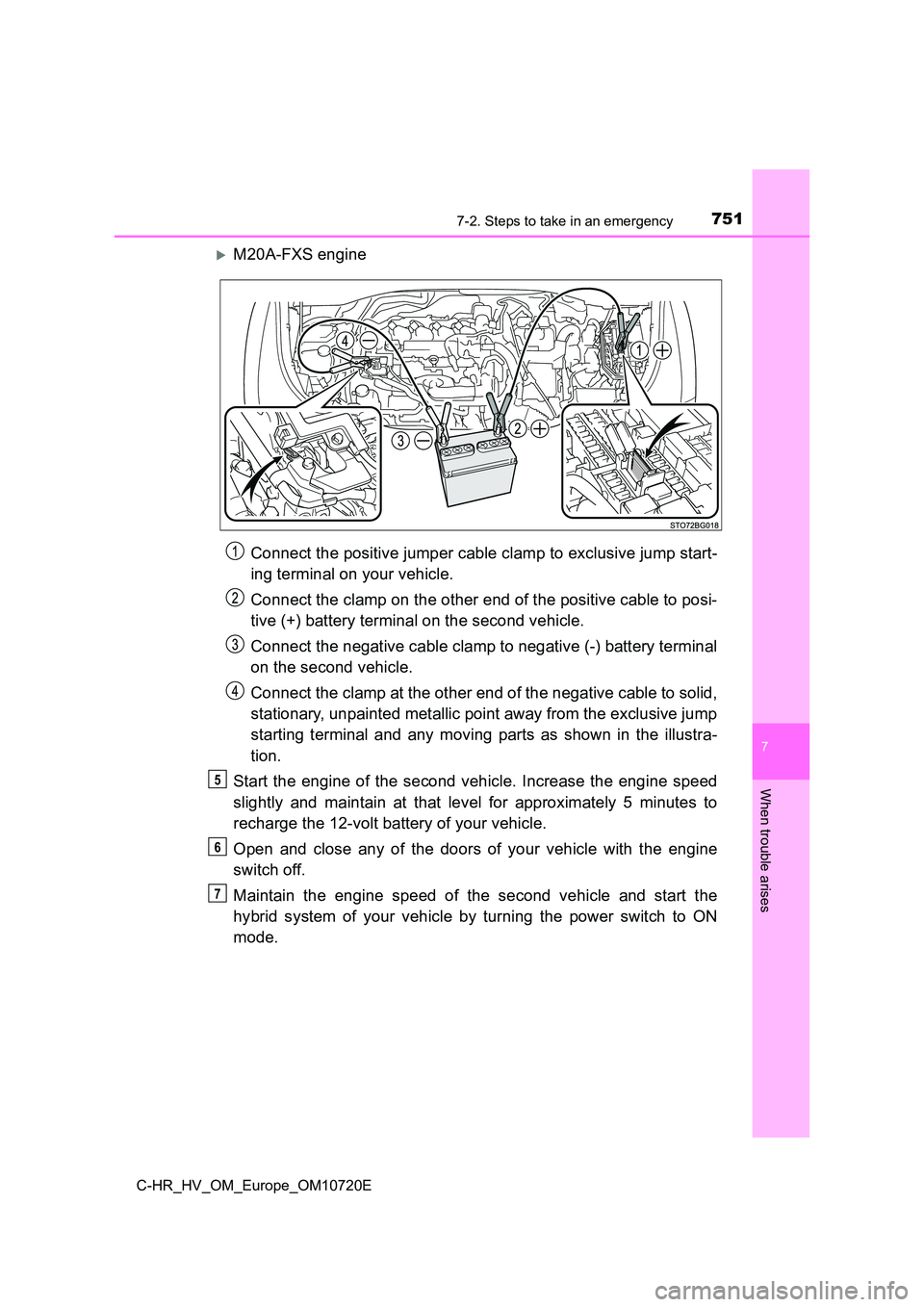
7517-2. Steps to take in an emergency
C-HR_HV_OM_Europe_OM10720E
7
When trouble arises
M20A-FXS engine
Connect the positive jumper cable clamp to exclusive jump start -
ing terminal on your vehicle.
Connect the clamp on the other end of the positive cable to pos i-
tive (+) battery terminal on the second vehicle.
Connect the negative cable clamp to negative (-) battery termin al
on the second vehicle.
Connect the clamp at the other end of the negative cable to sol id,
stationary, unpainted metallic point away from the exclusive ju mp
starting terminal and any moving parts as shown in the illustra -
tion.
Start the engine of the second vehicle. Increase the engine spe ed
slightly and maintain at that level for approximately 5 minutes to
recharge the 12-volt battery of your vehicle.
Open and close any of the doors of your vehicle with the engine
switch off.
Maintain the engine speed of the second vehicle and start the
hybrid system of your vehicle by turning the power switch to ON
mode.
5
6
7
Page 754 of 818
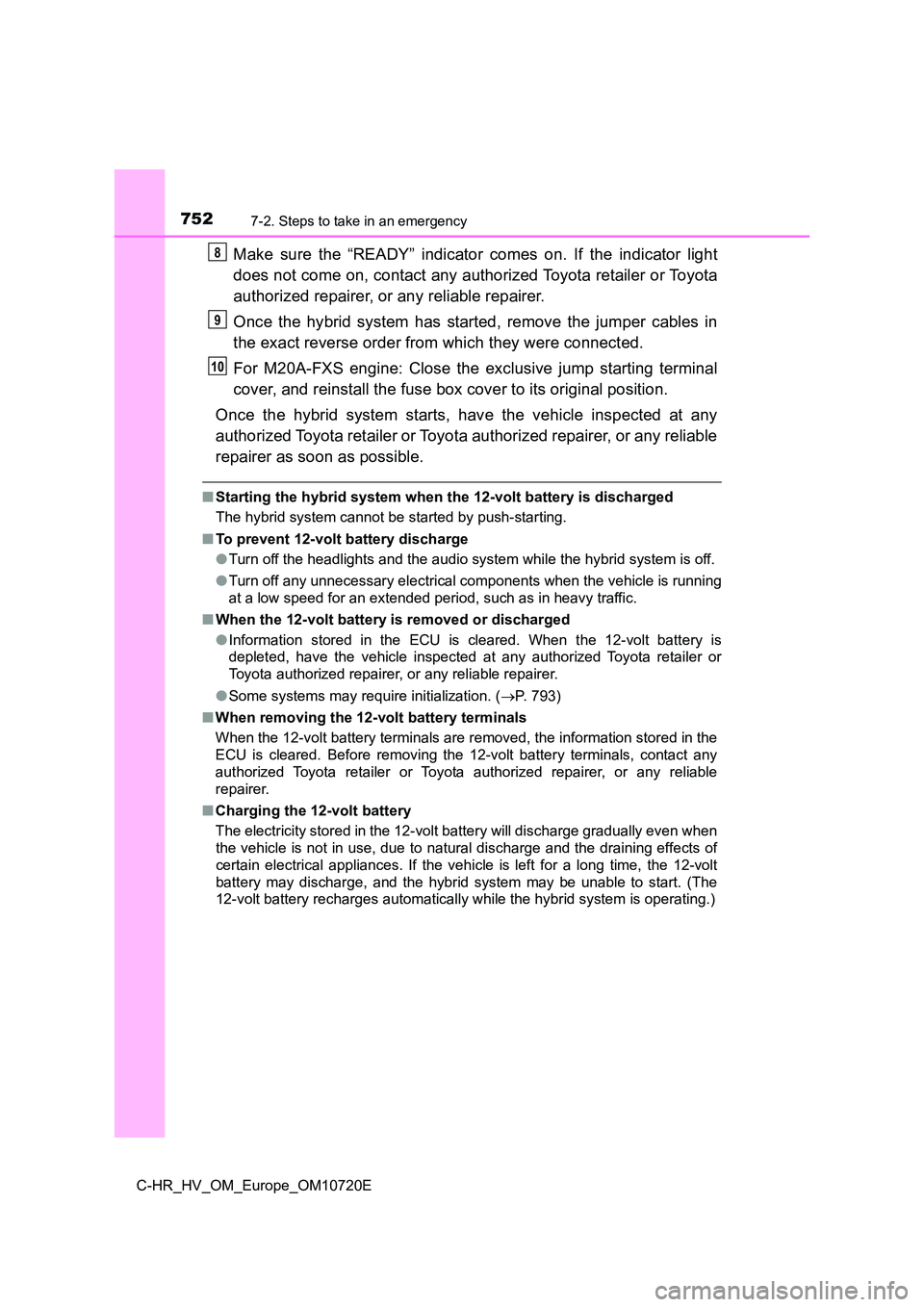
7527-2. Steps to take in an emergency
C-HR_HV_OM_Europe_OM10720E
Make sure the “READY” indicator comes on. If the indicator light
does not come on, contact any authorized Toyota retailer or Toy ota
authorized repairer, or any reliable repairer.
Once the hybrid system has started, remove the jumper cables in
the exact reverse order from which they were connected.
For M20A-FXS engine: Close the exclusive jump starting terminal
cover, and reinstall the fuse box cover to its original positio n.
Once the hybrid system starts, have the vehicle inspected at an y
authorized Toyota retailer or Toyota authorized repairer, or an y reliable
repairer as soon as possible.
■ Starting the hybrid system when the 12-volt battery is discharged
The hybrid system cannot be started by push-starting.
■ To prevent 12-volt battery discharge
● Turn off the headlights and the audio system while the hybrid system is off.
● Turn off any unnecessary electrical components when the vehicle is running
at a low speed for an extended period, such as in heavy traffic .
■ When the 12-volt battery is removed or discharged
● Information stored in the ECU is cleared. When the 12-volt battery is
depleted, have the vehicle inspected at any authorized Toyota r etailer or
Toyota authorized repairer, or any reliable repairer.
● Some systems may require initialization. (P. 793)
■ When removing the 12-volt battery terminals
When the 12-volt battery terminals are removed, the information stored in the
ECU is cleared. Before removing the 12-volt battery terminals, contact any
authorized Toyota retailer or Toyota authorized repairer, or an y reliable
repairer.
■ Charging the 12-volt battery
The electricity stored in the 12- volt battery will discharge gradually even when
the vehicle is not in use, due to natural discharge and the dra ining effects of
certain electrical appliances. If the vehicle is left for a lon g time, the 12-volt
battery may discharge, and the hybrid system may be unable to s tart. (The
12-volt battery recharges automat ically while the hybrid system is operating.)
8
9
10
Page 757 of 818
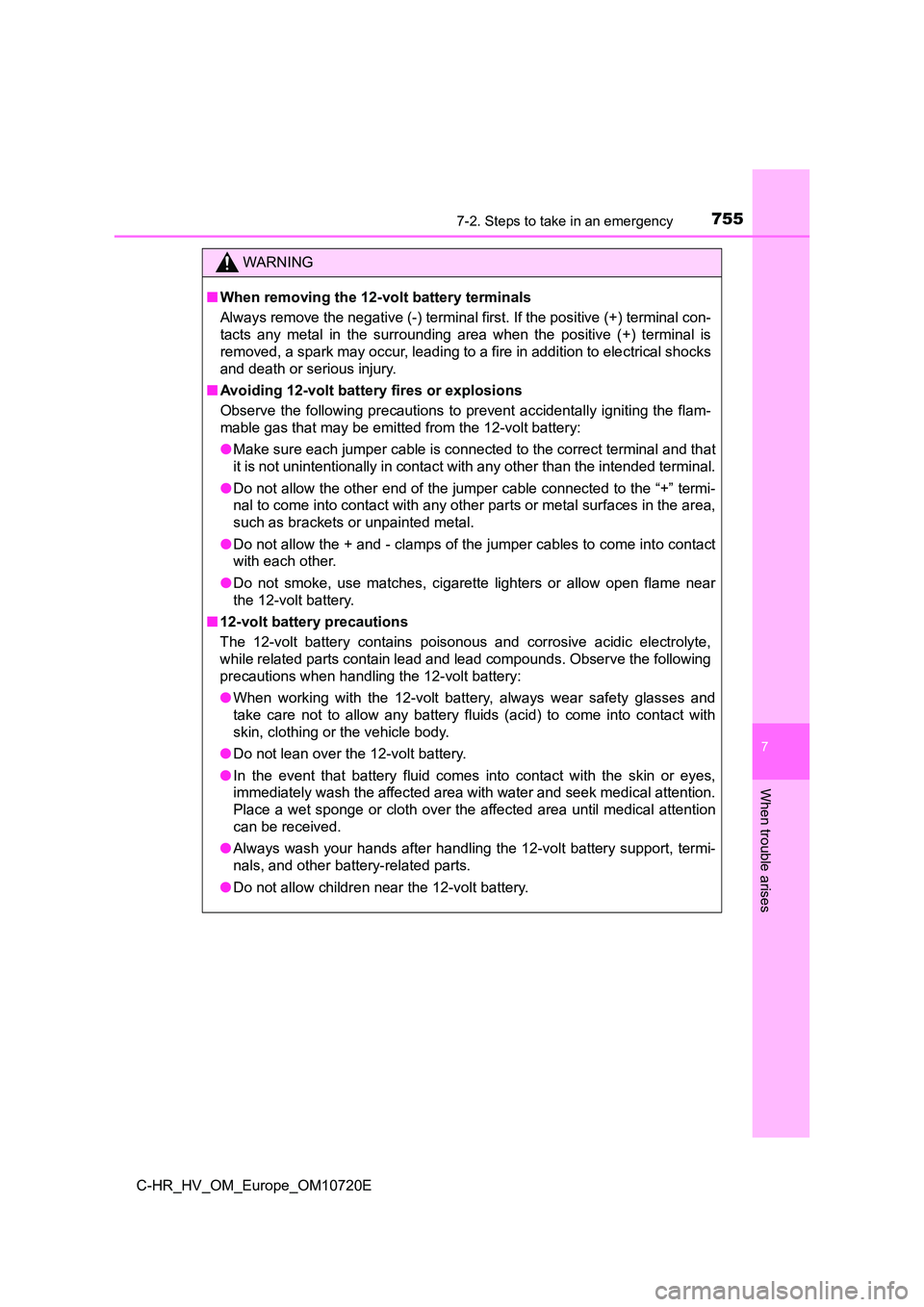
7557-2. Steps to take in an emergency
C-HR_HV_OM_Europe_OM10720E
7
When trouble arises
WARNING
■When removing the 12-volt battery terminals
Always remove the negative (-) terminal first. If the positive (+) terminal con-
tacts any metal in the surrounding area when the positive (+) t erminal is
removed, a spark may occur, leading to a fire in addition to el ectrical shocks
and death or serious injury.
■ Avoiding 12-volt battery fires or explosions
Observe the following precautions to prevent accidentally ignit ing the flam-
mable gas that may be emitted from the 12-volt battery:
● Make sure each jumper cable is connected to the correct terminal and that
it is not unintentionally in contact with any other than the in tended terminal.
● Do not allow the other end of the jumper cable connected to the “+” termi-
nal to come into contact with any other parts or metal surfaces in the area,
such as brackets or unpainted metal.
● Do not allow the + and - clamps of the jumper cables to come into contact
with each other.
● Do not smoke, use matches, cigarette lighters or allow open flame near
the 12-volt battery.
■ 12-volt battery precautions
The 12-volt battery contains poisonous and corrosive acidic ele ctrolyte,
while related parts contain lead and lead compounds. Observe th e following
precautions when handling the 12-volt battery:
● When working with the 12-volt battery, always wear safety glasses and
take care not to allow any battery fluids (acid) to come into c ontact with
skin, clothing or the vehicle body.
● Do not lean over the 12-volt battery.
● In the event that battery fluid comes into contact with the skin or eyes,
immediately wash the affected area with water and seek medical attention.
Place a wet sponge or cloth over the affected area until medica l attention
can be received.
● Always wash your hands after handling the 12-volt battery support, termi-
nals, and other battery-related parts.
● Do not allow children near the 12-volt battery.
Page 758 of 818
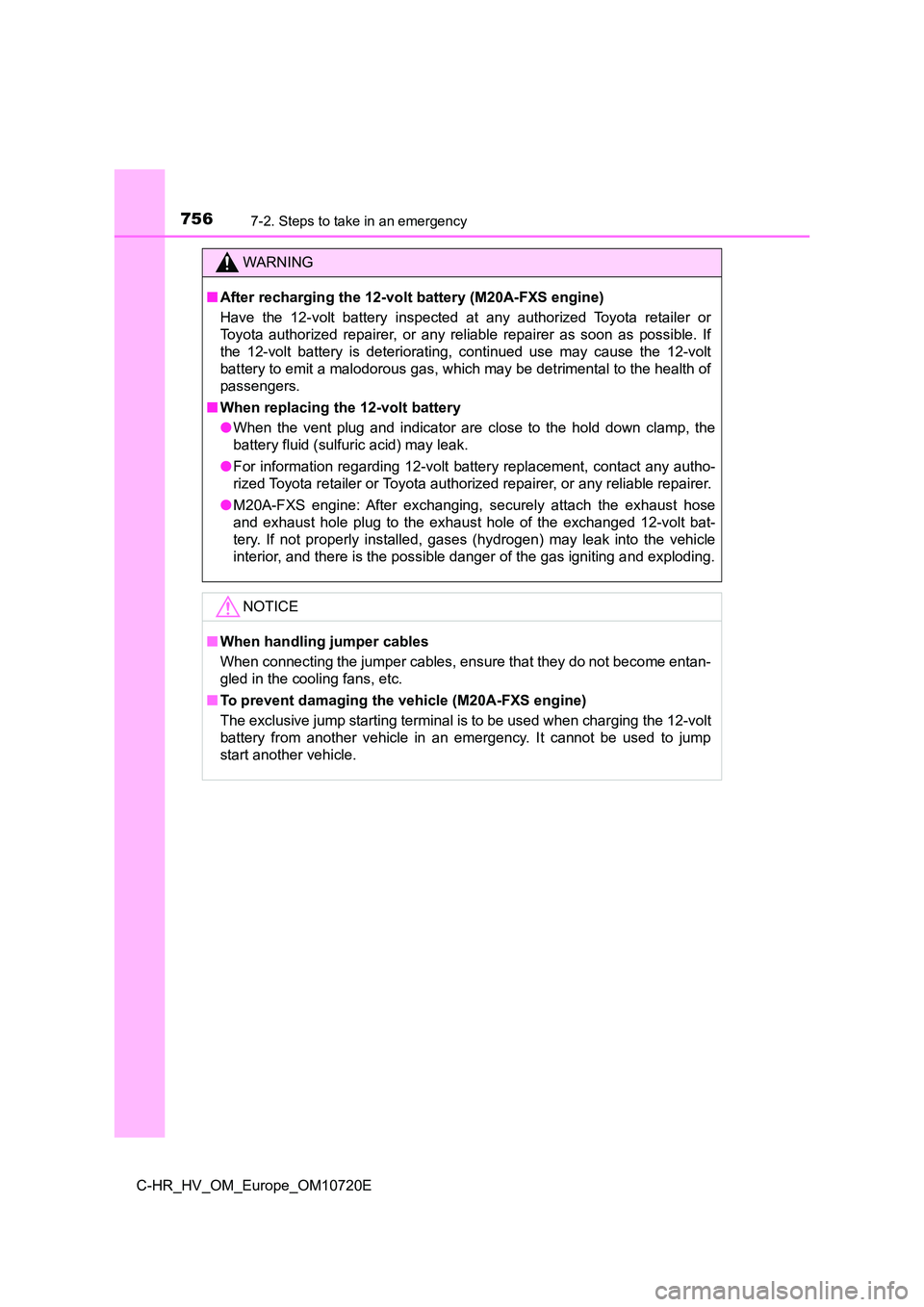
7567-2. Steps to take in an emergency
C-HR_HV_OM_Europe_OM10720E
WARNING
■After recharging the 12-volt battery (M20A-FXS engine)
Have the 12-volt battery inspected at any authorized Toyota ret ailer or
Toyota authorized repairer, or any reliable repairer as soon as possible. If
the 12-volt battery is deteriorating, continued use may cause t he 12-volt
battery to emit a malodorous gas, which may be detrimental to t he health of
passengers.
■ When replacing the 12-volt battery
● When the vent plug and indicator are close to the hold down clamp, the
battery fluid (sulfuric acid) may leak.
● For information regarding 12-volt battery replacement, contact any autho-
rized Toyota retailer or Toyota authorized repairer, or any rel iable repairer.
● M20A-FXS engine: After exchanging, securely attach the exhaust hose
and exhaust hole plug to the exhaust hole of the exchanged 12-v olt bat-
tery. If not properly installed, gases (hydrogen) may leak into the vehicle
interior, and there is the possible danger of the gas igniting and exploding.
NOTICE
■When handling jumper cables
When connecting the jumper cables, ensure that they do not beco me entan-
gled in the cooling fans, etc.
■ To prevent damaging the vehicle (M20A-FXS engine)
The exclusive jump starting terminal is to be used when chargin g the 12-volt
battery from another vehicle in an emergency. It cannot be used to jump
start another vehicle.